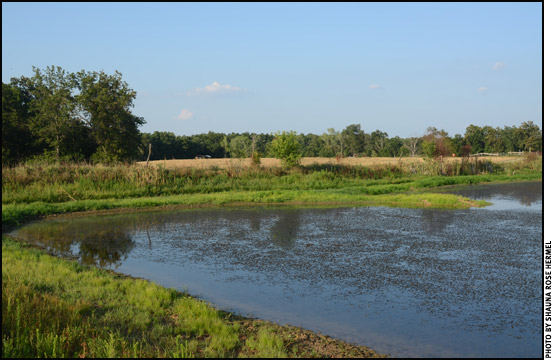HEALTH & NUTRITION...

Hot, Dry Weather Boosts Likelihood
of Blue-Green Algae
K-State specialists issue new fact sheet, review steps for proper testing.
This summer's searing heat is causing a host of problems for landowners, including the threat of toxic cyanobacteria, also known as blue-green algae, on lakes and ponds.
"Blue-green algae can sicken or kill livestock and other animals, and also poses a threat to humans," said Carol Blocksome, Kansas State University (K-State) research assistant professor in agronomy. "If blue-green algae are suspected, a water sample can be collected and sent to the Kansas State Veterinary Diagnostic Laboratory." Read more.
Extension Specialist Offers a Cattleman's Perspective
Beef extension specialist Ron Lemenager and ag educator Mark Kepler share some insights concerning the problems of nitrate poisoning in drought-affected forage in this video clip provided by Phil Reid and "The Beef Blog."
Duration of Immunity —
Confidence Labeled on the Vaccine
Take the guesswork out of managing respiratory disease.
A little extra information on a vaccine's label — like the duration of immunity (DOI) offered by the product — can help cattle producers select a respiratory vaccine that best fits their herd health program.
"Duration of immunity label claims can help give producers confidence that their cattle will be protected against respiratory disease throughout the high-challenge periods," says Jon Seeger, Pfizer Animal Health cattle and equine technical services. Read more.

Rick Rasby
Ridin’ Herd
Interesting times in the beef industry
Data say that of the last 16 years, 12 of those years recorded a reduction in beef cow inventory. During the last six years there was a steady reduction in beef cow numbers nationally. This reduction in cow inventory means fewer feeder calves. The lower feeder-calf inventory has put pressure on feedlot operators because of the increased competition for the calves that are available and excess bunk space in the feedlots. Read more.
 Dealing With Pasture Bloat
Dealing With Pasture Bloat
"Bloat occurs when rumen gas production exceeds the rate of gas elimination," explains Stephen Boyles, Ohio State University beef extension specialist. "The gas accumulates and causes distention of the rumen (left side of cattle). If the situation continues, the inflated rumen interferes with respiration."
"Cattle in trouble stand with head and neck extended, open-mouthed and drooling," describes David Van Metre, veterinarian and associate professor within the Colorado State University College of Veterinary Medicine and Biomedical Sciences. "They are too busy trying to breathe to swallow, and they drool saliva. When they become short on oxygen, they stagger and go down."
At this point, you must take immediate action to let gas out of the rumen, he explains, by "sticking" the distended rumen with a knife or trocar to prevent suffocation. Read more.
Stray Mexican Cattle Captured in Texas
Stray cattle pose potential risk of disease outbreak.
Stray livestock wandering between Chihuahua, Mexico, and Texas continue to present animal health concerns along the Rio Grande River in far West Texas say Texas Animal Health Commission (TAHC) and USDA officials. A total of 96 head of cattle (72 adults and 24 calves) originating from Mexico were recently captured and transported to government pens for inspection and testing. All of the animals tested negative for both bovine tuberculosis (TB) and brucellosis, diseases found commonly in Mexico. Read more.
Clostridial Diseases in Cattle
Several important clostridial diseases affect cattle. These include blackleg, redwater, malignant edema and several types of Clostridium perfringens. Most stockmen vaccinate against these, using a seven- or eight-way vaccine."This is probably the most widely used vaccine. If people do not vaccinate against these diseases, eventually they will lose cattle," says John Campbell, head of the Department of Large Animal Clinical Sciences, Western College of Veterinary Medicine in Saskatchewan. Read more.
Cattle Diseases: Common Conditions/Terms
Click here for a list of common conditions and terms related to beef cattle diseases, such as anaplasmosis, brucellosis, BVD, E. coli, IBR and others.
[Click here to go to the top of the page.]











